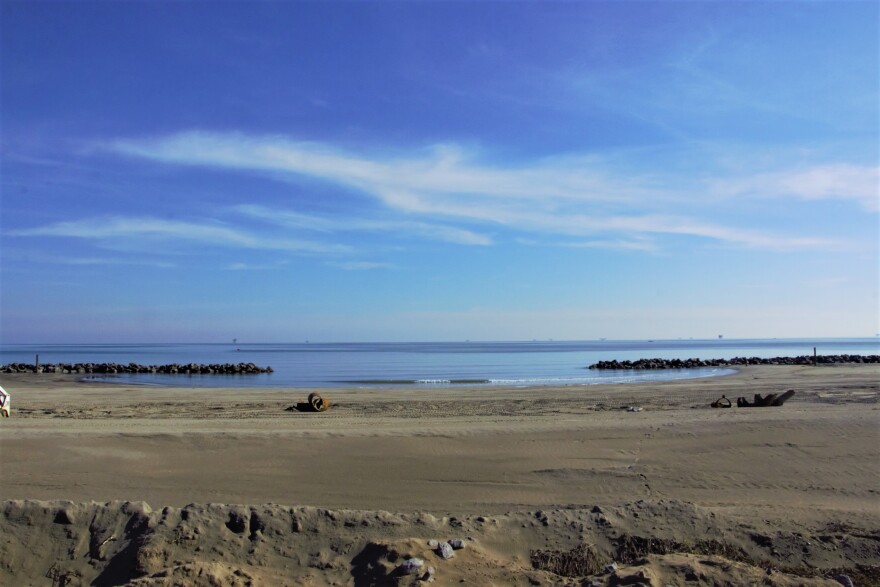When Hurricane Zeta hit Louisiana’s coast in October, it destroyed what was left of Grand Isle’s west end beach. After hold-ups with federal partners, the state has spent $7.5 million over the past few months to repair it.
As Louisiana’s only inhabited barrier island, Grand Isle has long been a fishing and recreational destination. Kate Chopin portrayed it as a summer playground for New Orleans’ elite in her complicated 1899 novel “The Awakening.”
Now it’s more of a working-class destination, though there’s less and less of it to enjoy each year.
The island is on the frontlines of climate change and coastal land loss, facing one of the highest rates of relative sea level rise in the world. Tidal flooding is increasing. Most of the homes are raised up high on stilts.
David Camardelle has been the mayor of Grand Isle since the ‘90s. On the day of the storm, he went down to the levee to watch it roll in.
“The waves were unbelievable,” he said.
Camardelle has seen his share of storms. The beach has been torn up over and over again by waves like these.
Back in the early 2000s, he got an idea. He was eating some fried chicken at a Conoco gas station and he looked down at how the napkins wrapped around the chicken- it made him think of a burrito - and a new way to build a levee.
“My idea was to come in and put black fabrics, make a burrito, and put it in front of these houses,” he explained. He called it a “burrito levee.”
The Army Corps installed a giant fabric tube stuffed with clay, which doesn’t erode as easily as sand.
It was the only thing left protecting the island after Zeta.
On a recent sunny afternoon, Mayor Camardelle walked up to the top of the levee and looked down on the sandy beach — a mile long and 760,000 cubic yards worth of sand.
“You can’t give up,” he said. “You just gotta keep fighting.”
In this case, the fight was with the Army Corps of Engineers. Camardelle had appealed to the agency to fix the beach, but federal bureaucracy can be slow. After months the Corps had only completed five rock jetties, which are important for protecting the beach, but not very useful when there is no beach.
Engineers with the Coastal Protection and Restoration Authority (CPRA) came in and hired a contractor to dredge sand from a mile out in the Gulf to rebuild the beach within a month.
“This is an island that needs a beach, that’s always going to be the case,” said CPRA engineer Rudy Simoneaux, who led the project.
The beach protects the island, and the beach, inevitably, will wash away. Simoneaux said the project will last about 10 years before needing to be replenished again.
“We can’t let the beach get back to the condition that it was in a month ago. Otherwise, the Gulf of Mexico is right up on the levee again.”
He said it’s going to take recurring investments in a fund to protect Grand Isle. At this point, no such fund exists. Repairs are made on a piecemeal basis. After every storm, and every federal disaster declaration, funds are cobbled together again to make repairs.
An Army Corps spokesman agreed that it would take a lot of money to continue to protect Grand Isle.
Camardelle wants more to be done. He wants the Corps to install more rocks. He wants the state to allocate more money.
“As long as there’s one grain of sand on this beach to put the American flag, I’m honored to tell you that we aren’t going anywhere,” he said.

Despite all of this, Denise Allemand and her husband bought their retirement home on the island. She grew up in Larose and visited Grand Isle with her family each summer, and those fond memories drew her back.
She’s a lawyer now, so she named their camp “Law and Disorder.”
“Law when I’m working,” she explained, “and disorder when I’m down here playing.”
As Zeta sped towards Grand Isle on a Wednesday at the end of October, Allemand and her husband hunkered down and hoped for the best. Because the storm moved so fast, they had no time to evacuate. The highway was covered with water, so they couldn’t leave.
“As the storm came through, we were grateful that it was fast-moving,” she said. “Unfortunately it did cause a lot of damage.”
When they finally left their house on the east side of the island to take stock of the damage, they saw that the whole beach to the west had washed away. The sand had been swept into the Gulf of Mexico, leaving no protection.
“There was a lot of trash,” she said. “There were a lot of power poles down, boats on the road. It was a mess.”
The storms will continue. The beach will wash away again. But as long as the island holds a nostalgic allure for people like Mayor Camaradelle and Denise Allemand, people will keep rebuilding again and again.
“Once this place goes away, we’re not getting it back,” Allemand said.
Support for the Coastal Desk comes from the Greater New Orleans Foundation, the Walton Family Foundation, and local listeners.





